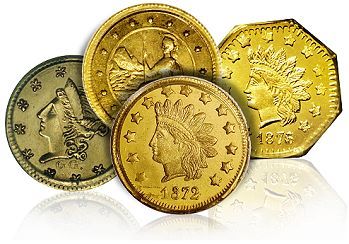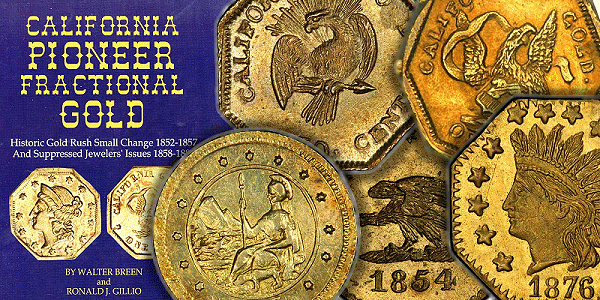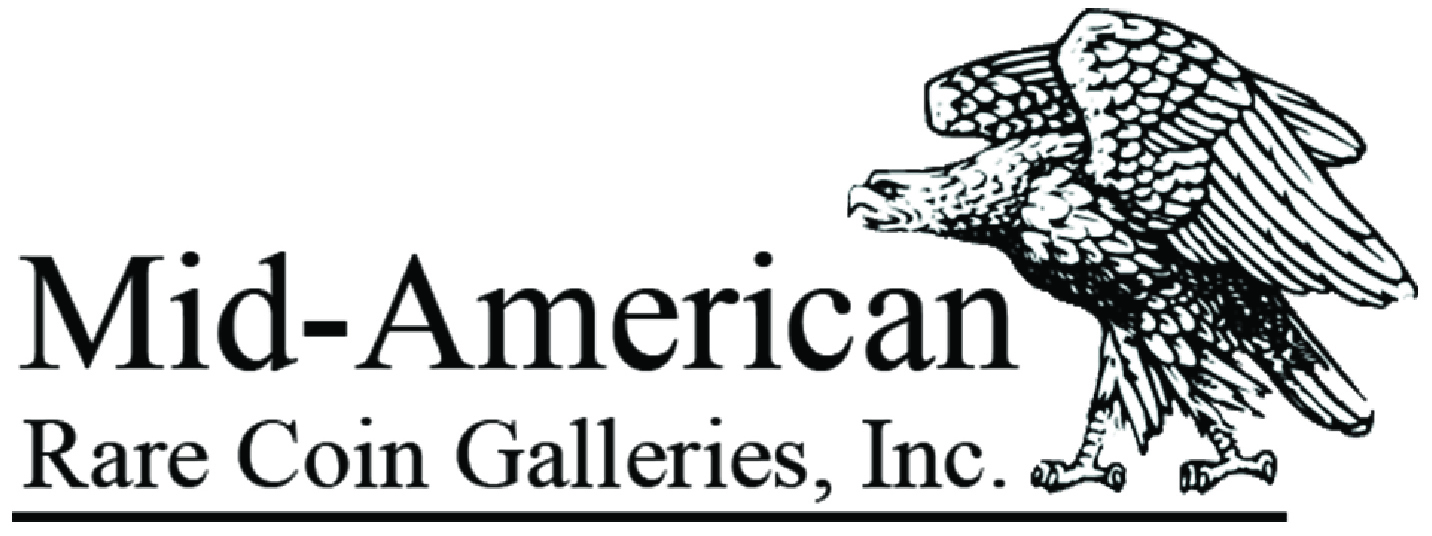Next week, Heritage Auctions will be offering the Maurice Storck Collection. Storck was a coin dealer who was active starting in the 1950s and famously attended the King Farouk sale that was held in Cairo, Egypt in 1954. When he died last year at the age of 97, he was the last US numismatist who attended that sale in person. His collection contains an interesting array of US rarities and will be warmly received, as are all old-time collections when they enter the marketplace.
While reviewing the catalog, one section was of particular interest to me: over three hundred lots of Californian fractional gold coins. This is a very comprehensive offering and is sure to garner considerable attention from specialized collectors of this series.
California fractional gold coins have always been one of my favorite series. In the 1980s, I assembled a large collection and later sold them, much to my regret today. Maurice Storck, like many coin dealers and collectors of the past, was probably drawn to their relatively low cost and historical significance.
 My appreciation for Californian fractional gold coins deepened several years ago when the Odyssey Marine Corporation was excavating the shipwreck site of SS Central America. I was hired to perform a series of appraisals as material was brought up from the seafloor. Coins were placed into plastic Tupperware containers along with the seawater for preservation purposes. Each container was like a miniature time capsule from the year 1857. It was one of the most interesting and exciting assignments of my numismatic career.
My appreciation for Californian fractional gold coins deepened several years ago when the Odyssey Marine Corporation was excavating the shipwreck site of SS Central America. I was hired to perform a series of appraisals as material was brought up from the seafloor. Coins were placed into plastic Tupperware containers along with the seawater for preservation purposes. Each container was like a miniature time capsule from the year 1857. It was one of the most interesting and exciting assignments of my numismatic career.
I had the opportunity to closely examine thousands of wonderful US gold coins. As much as I found them interesting, however, my most fascinating discovery was the presence of quantities of California fractional gold coins. These tiny gold coins clearly circulated during the California Gold Rush. It’s hard to believe that something as small as the California gold quarter dollars actually was used as money. The proof was in these Tupperware containers.
Currency Born from Necessity
Due to the scarcity of smaller denomination coins during the Gold Rush, privately minted quarter, half, and dollar coins were minted starting in 1852. These coins circulated alongside smaller-size silver coins from around the world, many of which were also found on the Central America. The fractional gold coins were lightweight but were still accepted in commerce.
Dozens of private companies minted California fractional gold coins, and there are about 575 different varieties known of all types. The standard reference for the series is California Pioneer Fractional Gold by Walter Breen and Ron Gillio. Coins are assigned BG numbers when attributed.
The Coinage Act of April 22, 1864, made private coinage illegal in the US, but the law was not fully enforced until 1883. The coins issued after 1883 are considered tokens and do not state a denomination in most cases. There are also plentiful modern replicas that are gold-plated and nearly worthless.
Go Back in Time to the Gold Rush
Collecting California fractional gold coins is a fun and fascinating pursuit, as many of the coins are tangible links to one of the most exciting eras of American history. I particularly like the Type One issues from 1852 to 1857 that actually circulated or were struck during the Gold Rush.

The Type One California fractional gold coins were produced in six major configurations. These include quarter, half, and dollar coins that are either round or octagonal. This six-coin Type set would be a great way to start a collection of this intriguing series. For the specialist, there are hundreds of varieties and types. There are also a few unique designs, such as the “Defiant Eagle” quarter dollar, that are extremely rare. The “Peacock Reverse” is another favorite.
Later issues that were struck from 1858 to 1882 were mostly produced as tokens for the collector or souvenir market. These issues are usually found with Liberty heads and Indian heads, but some examples were produced with the head of Washington. They were also struck in round and octagonal configurations. Many were produced in limited numbers and come very Proof-like in appearance. Collectors often assemble Type sets of this series as well with examples of the Indian and Liberty types in the various denominations and shapes.
A Boon to the Series
Years ago, collecting California fractional gold coins was tedious, to say the least. The coins are tiny and are literally small slivers of gold. Third-party grading has been a boon to this particular series. When the coins are certified, they become easy to manage and highly collectible. Certification also performs the important task of assigning each coin the proper variety attribution. Collectors of the past had to guess the coins’ rarity based on experience or appearance at auction. The NGC Census provides an extremely valuable tool for assessing rarity.
A few years ago, I became Senior Editor of the Guide Book of United States Coins (the Red Book), and I tasked myself with looking for areas of possible improvement. One section that we greatly improved last year is that on California fractional gold coins. Now, much more emphasis is placed on the 1852-1857 issues that were struck and used during the actual Gold Rush.
California fractional gold coins are affordable and one of the most interesting series of coins struck in the US. You can purchase one or two coins as relics of this era, or go “all in” by trying to assemble as many different varieties as possible. It would be nearly impossible to complete a variety set, but the challenge would be extremely exciting.
